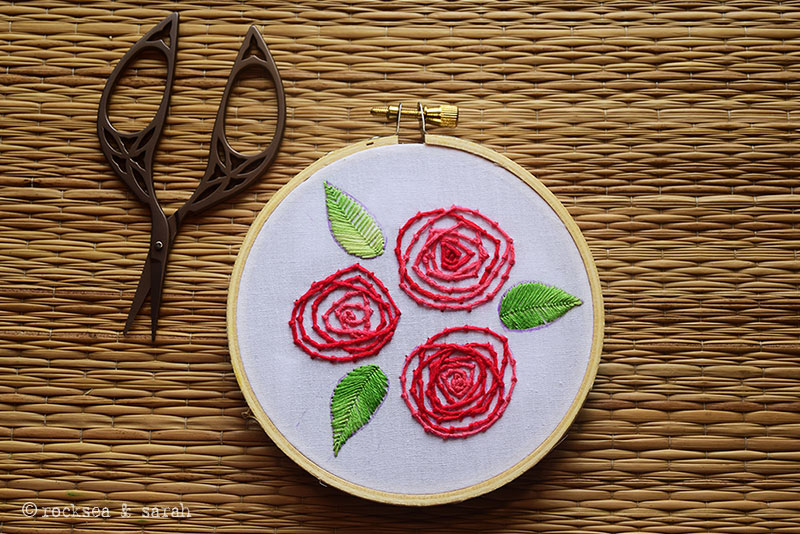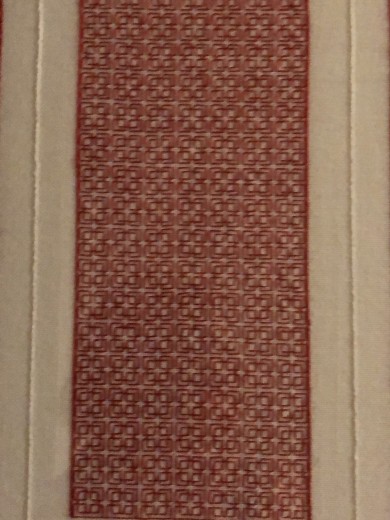Common Mistakes Made in Hand Embroidery
Hi there!
June was such a busy month, I began July with a break of two weeks. During that time, I interacted with the embroidery circle — A Needle Bit of Joy, to check on what they were up to. Mostly, I help them decide patterns and colors, and also discuss some common mistakes. So, I thought maybe I should share some of these with you this month.
Common mistakes made by beginners
As beginners, it is common to make mistakes in hand embroidery because we are not aware of what could go wrong or what could make the situation better. Don’t worry, these mistakes are made by seasoned embroiderers too!
1. A bad posture and poor lighting
As a beginner, we tend to plonk ourselves wherever we feel and start stitching, hunching our backs forward. I have done it too. It won’t be long before you find yourself with an aching back, neck, or hands. Poor lighting can give you a headache. Choose a comfortable place to sit where you can rest your back and neck. It will be great if you can rest your working arm too. Sit at a place where you have ample daylight. If you are using a lamp while stitching, make sure it gives enough light to easily see the details.
2. Compromising on good quality material
Hand embroidery is a very affordable hobby. Standard materials can be purchased without shelling out much. It might seem a perfect idea to buy cheap threads, needles, and hoop as a beginner. You might be compromising on the quality, and unfortunately, these materials need not justify the effort you would put in to stitch. An inferior quality thread can bleed and look unattractive. A bad quality needle can damage your fabric. A poor quality hoop can ruin your fabric or not even serve its purpose well. This does not mean that you splurge in costly and unnecessary materials. Start with the essential tools—threads( stranded cotton), fabric, hoops, and needles.
 Basic embroidery tools, many of which are re-usable.
Basic embroidery tools, many of which are re-usable.
3. Not using the right transferring tools
Use washable or soluble pens over your fabric. If they are not available, just use a pencil. Avoid regular pens and permanent markers. A single wrong stroke can spoil your pattern. Sometimes the traces show through the stitches and can look bad.
4. Wash or not to wash
Some fabrics have the tendency to shrink or change upon the first wash, like particular cotton fabric. Always soak and wash such fabric before you start the project. Now, if the embroidery is for framing purposes, I will not insist on it.
5. Dirty hands
Approach hand embroidery with clean hands. Keep them in a clean place. Do not bring food or any kind of coloring near it. You do not want your fabric to be smudged with dirt and colors that might not even come off.

6. Not using a hoop
When I started out with hand embroidery, I had little idea of the importance of an embroidery hoop. In fact, I had stitched without a hoop for a long time. It did make my life a little difficult in its own ways until I discovered the power of the hoop. I never let it go since. Always use a hoop. Buy at least one. The best size would be a 6″ hoop—not too big, not too small.
Mounting the fabric on a hoop makes it taut and tight. This makes sure you do not pull the fabric too tight or leave the stitch too loose. It also helps when you are dealing with stitches that require both your hands.
7. Not using the right needle
The choice of needle is absolutely crucial for your project. Have an assortment of needles with you. Use a sharp-tipped needle on a regular fabric and NEVER on Open weave fabric like the aida (the kind you use for cross stitching). Similarly, do not use a blunt needle over a tightly woven fabric like cotton or silk—it just would not pass smoothly and damage the fabric. If you are not sure which size of needle to use, test stitching with it on the corner of the fabric and test how comfortable it feels.
8. Starting with big projects
This, I speak out of my own experience. As a beginner, the first thing you need is to see your own creation and see it fast! We are always tempted to take big ambitious stitching, unaware that it might last days and weeks to finish. This will only wear off your patience and chances are, that you give up. Begin with smaller projects with simpler stitches—something you can finish in a day or two. It helps you appreciate your efforts and feel proud of it. Give yourself a pat on the back and slowly build on the size of your projects. Even as you work on big projects, remember to sprinkle your time with smaller ones- it keeps you encouraged.
 A small floral project using two stitches done over a 4″ hoop. Time taken: 2 hours.
A small floral project using two stitches done over a 4″ hoop. Time taken: 2 hours.
9. Too long threads
The length of thread is always confusing when you start out. I used to pull out long strands of thread, thinking that it will last longer. Besides having been difficult working with long threads, halfway through, the threads wore off its sheen and health. This is because it has been passing many times through the fabric, wearing off each time. So, how long should the thread be? Well, as long as you can pull maximum with your hand! Thus, the maximum length must be the length of your arm. This also depends on what kind of stitching you are doing.
10. Panicking with mistakes
Chances are that you will make stitching mistakes when you start off. First thing—do not panic. Even seasoned stitchers make mistakes. So what can be done? Try to improvise it—set the wheel of creativity on a roll! Most of the time you will see that the mistakes can be rectified with simple tricks or turned into something better.
Have you made any of these mistakes? What mistakes have you made as a beginner? How did you rectify them or make it better? Put them in the comments and let’s talk about it. Your comments might help another beginner to save his/ her day!
This month in Sarah’s Hand Embroidery
We added new projects, patterns, and stitches in the last month for you all to learn, enjoy, and make something beautiful.
- Projects – One more leaf has been added to the ongoing Leaf Embroidery Project. This time it is the Closed Fly Stitch that fills a beautiful tropical leaf. If you have missed the newsletter, you can check the Closed Fly Stitch Leaf now, and use them alongside our Flower Embroidery Project.
- Patterns – This time you will learn a new 3SAT pattern, using the Coral Stitch, Ray Stitch, and Tulip Stitch worked over a beautiful pattern of wild grass.
- New Stitch – The newest stitch to make an appearance in our Stitch Dictionary is the Closed Herringbone Stitch.
- New eBook – We came out with a new book this month, Hand Embroidery for Beginners. For those who want to just know the basic stitches and start making beautiful embroidery pieces, this book is the right choice!

 Picture Dictionary – We had also released a Stitch Picture Dictionary for quick reference. It is trending #1 in Amazon in the new releases! All our subscribers were sent one for free as our token of appreciation for being with us and supporting us through our journey!
Picture Dictionary – We had also released a Stitch Picture Dictionary for quick reference. It is trending #1 in Amazon in the new releases! All our subscribers were sent one for free as our token of appreciation for being with us and supporting us through our journey!
Share your comments and creations with us. We have a picture-upload option which you can use while posting comments!
Warm regards,
Sarah










Hi Sarah, I have just found your fabulous group and subscribed and wondered would it be possible to have the Picture Dictionary sent to me, I am sort of a beginner,have done lots of cross stitch but really want to learn embroideryand Blackwork…. thank you from a wet and windy South Wales, UK!! xx
Hi Annie,
Thank you for subscribing to our website. I have emailed you the link to download the Picture Dictionary. Please check your inbox (and your spam folder too) for the email. Let me know if you have received it. 🙂
Enjoy stitching!
Hi Sarah,
I am also a subscriber and did not receive the Picture Dictionary. I checked spam and junk mail and did not find it there :-(.
Halima
Hi Halima,
Please provide your email id or full name. It will help me to check and send you an email. Thank you. 🙂
Regards,
Sarah
Hi Sarah. I think I’m a subscriber, but I did not get the Picture Dictionary. Suzanne Brownrigg
suzannebrownrigg68@gmail.com
Hi Suzzane,
The newsletter could have ended up in your junk email folder. I have sent you an email. Please check your junk folder if you do not find it in your inbox. Hope you enjoy our Stitch Picture Dictionary. 🙂
No one ever said Blackwork had to be black, so here is something I just finished—red silk on linen, a Cappadocian father’s cross.


Wow! How beautiful! I am inspired to do a few pieces of Blackwork again! Thank you for sharing this. Love it! 🙂
I love this list and have used your emails to learn new stitches. One more mistake I learned not to make: not practicing stitches or patterns on a sampler before starting for real. Easy and a fun record of your projects over the years . And I do black work mostly because it’s one art that does not use a hoop.
Uh—Blackwork (ugh autocorrect!)
Thank you, Victoria for adding that point in! How did I ever miss that! You are right, trying out any stitch on a doodle cloth or sampler is always wiser than going directly onto the actual project.
I love Blackwork! I have done a few and later I extended it to Assisi Work. 😀 Please do share some of your works here- would love to see them. 🙂
Thank you Sarah for your kindness in sharing these things with us.
My pleasure, Isabel! ☺️
Hi Sarah, love your tutorials. I am a beginner. would you be able to suggest an example for a good quality embroidery hoop and threads.
Hi Sindhya,
Anchor is a good brand for threads. A bamboo or wood hoop of 6″with a metal nut is good. You can look for it Amazon, or you can look for it in shops that are locally available. ☺️
Thank you so much Sarah
Hi Sarah
Thanks for showing me new embroideries. Each one better than the other.
Mary Fatima Kelath
Thank you, Fatima! ☺️
Thank you for all your advices and generosity sharing your knoledge and art.
Best regards
Thank you, Sandra. 🙂